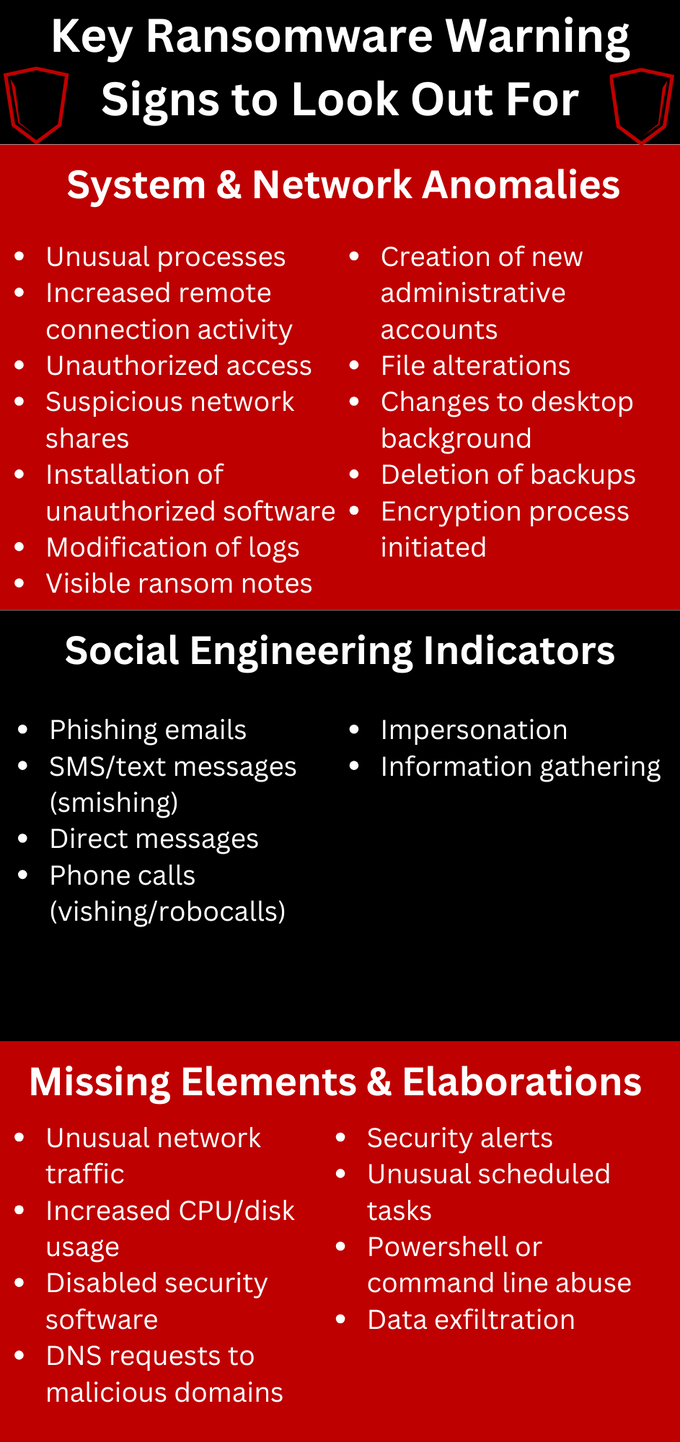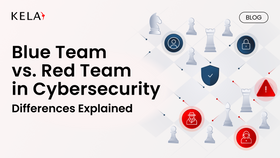Spotting Ransomware Attacks: What to Look for in Your Business Systems
Ransomware attacks steal and encrypt your data, using its inherent threat to blackmail you into paying a ransom before receiving instructions for recovery. Luckily, there are proactive security steps you can take to spot and manage potential ransomware attacks.
Updated May 25, 2025

The modern digital landscape has seen such a rise in ransomware attacks that they have become an alarmingly common and devastating threat to businesses of all sizes, with over 5,320 victims tracked by us in 2024 alone. These malicious attacks, where cybercriminals encrypt critical data and demand payment for its release, are no longer isolated incidents. They've evolved into a pervasive and highly profitable criminal enterprise, causing significant financial losses, operational disruptions, and reputational damage.
Understanding the telltale signs of a potential ransomware infection within your business systems is crucial for proactive defense and swift response. This blog post will explore the key indicators to watch for, empowering you to safeguard your valuable data and maintain business continuity in the face of this ever-present threat.
» Protect your business from ransomware today: Try KELA for free
What Is Ransomware?
Ransomware is a highly dangerous type of malware that encrypts the victim's data, blocking their access until a ransom is paid.
Unlike other types of malware that use advanced techniques to remain hidden in infected systems, ransomware uses its inherent threat to blackmail the victim into paying a ransom before they receive instructions for recovery, usually requiring payment in difficult-to-track currencies like Bitcoin.
» Learn more about how ransomware operators gain access
Types of Ransomware
Ransomware can be installed through targeted attacks, such as unauthorized access, exploitation of vulnerabilities, malicious email phishing campaigns, and unlicensed software. With the increasing number of ransomware attacks in recent years, they can be distinguished by their objectives and modes of operation:
- Crypto ransomware: The most common type of ransomware. It encrypts files, making them inaccessible until a ransom is paid in untraceable cryptocurrency. This is the foundation of many other types, including double and triple extortion. Examples include CryptoLocker, WannaCry, and Ryuk.
- Double extortion ransomware: Encrypts and steals data, threatening to release the stolen information if the ransom is not paid. It puts pressure on the affected organization due to the potential reputation damage and legal liabilities. Examples of double extortion ransomware are Lockbit, Cl0p, Anubis, and Akira.
- Triple extortion ransomware: In addition to encrypting, stealing data, and threatening to publicly disclose the victims' data, triple extortion ransomware threatens the victim's suppliers, partners, organizational leaders, and their families by conducting denial-of-service attacks. Examples of ransomware that employ these tactics are BlackCat (AlphV), Cl0p, and Revil.
- Ransomware-as-a-service (RaaS): A recent modality of exploitation and commercialization that allows less experienced cybercriminals to launch sophisticated attacks with off-the-shelf ransomware for a fee or percentage of the ransom, essentially increasing threat levels through cooperation. Examples of RaaS include Cyclops' Knight, BlackCat (AlphV), Qilin, Conti, and Black Basta.
- Scareware: A type of malware that claims to have encrypted the victim's files and demands payment, when in reality, nothing has been encrypted. An example of scareware is the ALC Ransomware.
- Mobile ransomware: Specifically targets mobile devices, often Android-based, locking the device or encrypting files. Mobile malware is extremely variable and might present itself as a fake application or be tied to a malicious download.
- Disk wiper ransomware: A particularly destructive form of malware. Instead of just encrypting files, it overwrites them, making recovery extremely difficult or impossible even after paying the ransom. This type of ransomware is sometimes used to mask the destruction of evidence. An example of disk wiper ransomware is NotPetya.
» Learn more about how hackers gain entry to your systems
Key Ransomware Warning Signs to Look Out For
1. System & Network Anomalies
- Unusual processes: Unexpected or unknown programs running on computers or servers.
- Increased remote connection activity: A surge in remote desktop protocol (RDP) or VPN connections, especially outside of normal business hours.
- Unauthorized access: Logins from unfamiliar locations or at odd times.
- Suspicious network shares: New or unexpected network shares being created or accessed.
- Installation of unauthorized software: Programs installed without IT approval.
- Modification of logs: Attempts to delete or alter system logs to cover tracks.
- Visible ransom notes: Text files or pop-up windows demanding ransom payments.
- Creation of new administrative accounts: New user accounts with elevated privileges.
- File alterations: Unusual file renaming, encryption, or movement.
- Changes to desktop background: Ransom notes or strange images appear as the desktop background.
- Deletion of backups: Attempts to delete or disable backup systems.
- Encryption process initiation: Noticeable slowdowns or increased disk activity as files are encrypted.
» Did you know? Ransomware groups are now selling network access directly
2. Social Engineering Indicators
- Phishing emails: Emails with suspicious attachments or links, especially those claiming to be from law enforcement or government agencies, delivery services (package tracking), and financial institutions (payment due), as well as emails using timely or emotionally charged themes such as COVID-19 or other current events, the Olympics or other large sporting events, and fake recruitment sites or job offers.
- SMS/text messages (smishing): Similar to phishing, but through text messages.
- Direct messages: Suspicious messages on social media or messaging platforms.
- Phone calls (vishing/robocalls): Calls requesting sensitive information or urging immediate action.
- Impersonation: Attackers posing as trusted individuals (e.g., colleagues, vendors, job candidates).
- Information gathering: Attackers gather information about target individuals like the CFO or other high-value targets and their colleagues.
» Here's how to prevent phishing attacks before they catch you
3. Missing Elements & Elaborations
- Unusual network traffic: Sudden spikes in network traffic, especially to or from unusual locations, and lateral movement inside of the network.
- Increased CPU/disk usage: Unexplained high CPU or disk utilization, indicating encryption activity.
- Disabled security software: Attempts to disable antivirus or endpoint protection.
- DNS requests to malicious domains: Monitoring DNS requests can reveal connections to known malicious domains.
- Security alerts: Pay very close attention to any and all security alerts that are generated.
- Unusual scheduled tasks: Malicious actors will often create scheduled tasks to run malicious scripts or programs.
- PowerShell or command line abuse: Unusual use of command line tools or PowerShell.
- Data exfiltration: Large amounts of outbound network traffic that indicate data being copied off the network.
» Learn more: The ransomware path from start to end
Ransomware Prevention and Protection Techniques to Secure Your Systems
The risks of ransomware attacks can be reduced if companies implement robust security measures, including:
- Vulnerability patching: Prioritize and promptly apply security patches, especially for edge devices and high-risk systems. Implement robust asset management to ensure all systems are accounted for and patched.
- Layered security: Implement a defense-in-depth strategy using multiple security layers, such as web application firewalls (WAFs); virtual private networks (VPNs); endpoint detection and response (EDR) solutions; security information and event management (SIEM) systems; and security orchestration, automation, and response (SOAR) platforms.
- Data backups: Implement regular and reliable data backups stored offline or in immutable storage and test them regularly. Also, ensure backups are isolated from the primary network to prevent encryption.
- Incident response teams: Establish a dedicated incident response team with a well-defined plan. Regularly evaluate and improve the team's capabilities.
- Identity and access management (IAM): Implement strong IAM controls like multi-factor authentication (MFA). Monitor for access anomalies, such as unauthorized access attempts or logins from unusual locations and times.
- Security awareness training: Provide regular security awareness training to employees, focusing on social engineering and phishing prevention.
- Penetration testing: Conduct regular penetration tests to identify and address vulnerabilities.
- Network segmentation: Segment the network to limit the attack surface, monitor for lateral movement, and contain potential ransomware infections.
- No ransom payment: Establish a policy of never paying ransom demands. Paying encourages further attacks, and there's no guarantee of data recovery.
- Principle of least privilege: Implement and enforce the principle of least privilege across all systems and applications to ensure that all employees only have the minimum level of access necessary to perform their duties. Regularly review and revoke unnecessary privileges.
» Worried you might be in danger? Here's how to know if you are an ideal ransomware victim
How to Set Up an Incident Response Plan
A solid incident response plan is crucial for minimizing the impact of a ransomware attack. This plan should be a living document, evolving with your organization and the threat landscape. It should also clearly document roles and responsibilities to minimize the time between discovery and action.
Here's a breakdown of the key components:
- Readiness assessment: Evaluate your incident response team's capabilities, operational readiness, and recovery time objectives (RTOs).
- Dynamic response & recovery: Integrate incident response and disaster recovery plans, focusing on data backups and redundancy. Regularly revise these plans based on emerging threats.
- Triage & data sensitivity: Ensure the team is trained to quickly assess the severity of an attack and identify affected systems containing sensitive data.
- Rapid containment & evidence preservation: Develop a strategy for rapid containment while preserving forensic evidence.
- Legal & regulatory compliance: Address all relevant legal and regulatory considerations.
- Well-rehearsed recovery: Establish a detailed recovery procedure for restoring encrypted and wiped systems.
- Testing & validation: Test your plan through tabletop exercises, red team exercises, regular backup tests, vulnerability scanning, and retainers with incident response companies.
» Not convinced? Here are the reasons you need cyber threat intelligence
Stay Ahead of the Ransomware Curve With Cyber Threat Intelligence
Ransomware remains a persistent and evolving threat, demanding a proactive and multi-layered defense. Understanding the various ransomware types, recognizing early warning signs, and implementing robust prevention strategies are essential. However, the true advantage lies in anticipating attacks before they occur—this is where cyber threat intelligence becomes invaluable.
By leveraging threat intelligence platforms like KELA, organizations can gain critical insights into attacker infrastructure, tactics, and emerging threats. We provide actionable intelligence by identifying compromised credentials, vulnerabilities, and patterns of initial access broker activity on the deep and dark web, allowing for a more informed and targeted security posture.
» Ready to begin? Set a FREE session with our experts






